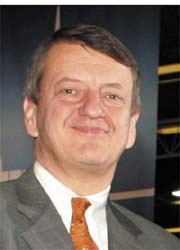The contribution of the anaesthesiologist
Since its early beginnings in Europe, during the polio epidemics of the 1950s, intensive care medicine has grown to become a specialty in its own right and the intensive care unit (ICU) occupies an increasingly important position in every hospital. Intensive care doctors are responsible for the management of very sick patients often with multiple and complex disease processes, and ICUs are now distinct areas of the hospital where such patients, who need specialized, 'intensive' (in terms of equipment and staffing levels) care can be managed in an environment that groups the necessary equipment and facilities.
Report: Jean-Louis Vincent

Historically, medical and surgical ICUs developed separately and were managed, respectively, by medical and surgical/anaesthetic teams, but with the growth of intensive care medicine, these separate units have progressively been combined into large, multidisciplinary ICUs. Indeed having separate ICUs for different groups of patients is now a rather outdated concept, because the initial surgical or medical status of a patient is only one small aspect of their need for intensive care; for example, are there really any great differences in surgical or medical patients with acute exacerbation of chronic obstructive pulmonary disease (COPD), or with pancreatitis, or acute respiratory distress syndrome (ARDS)? The real management of the intensive care patient focuses around the organ failure(s) (respiratory, cardiovascular, renal, haematological, neurological, etc.) associated with the underlying disease process, and this has little to do with the original medical/surgical nature of the patient. Nevertheless, ICUs have evolved differently in different geographical areas, with most ICUs in the US remaining either medical or surgical.
The background training of intensive care doctors has also varied over time. In most countries, physicians wishing to specialize in intensive care medicine must still obtain a qualification in another specialty first, and then spend an additional training period in the ICU (which is usually considered as a sub-specialty). In the US, the majority of intensivists are respiratory physicians starting from the management of respiratory failure. However, in Australia and Spain it has been possible to choose critical care medicine as a primary specialty, and this pattern in likely to be copied soon by other countries. Within Europe, the majority of intensivists have come from a background in anaesthesiology, partly as a result of the impact of the polio epidemics when the focus of the fledgling ICUs was respiratory care and ventilation, very much the domain of the anaesthesiologist. In Europe, it is estimated that a small majority of intensivists still have an anaesthesiology background, while other specialties are increasingly represented (internal medicine about 25-30%, paediatrics
about 10%, surgery about 5%).
However, there are important international differences within Europe. For example, in Scandinavia and Italy, virtually all ICU doctors are anaesthesiologists; similarly, most intensivists in Germany and the UK have an anaesthesiology background. In some countries, notably Germany, the place of intensive care medicine as a separate specialty is causing considerable debate, with some doctors wanting to become independent of their anaesthetic tasks to focus on intensive care, whilst others are concerned that the specialty of anaesthesia without its ICU component would be less attractive, thus drawing in fewer young doctors.
Importantly, the input of a full-time intensivist on the ICU has been shown, in many studies, to be associated with improved outcomes. However, intensive care medicine is becoming increasingly sophisticated and changing rapidly as ongoing research offers insight into the disease processes that affect critically ill patients and as new techniques of diagnosis, monitoring and treatment are developed. Keeping up to date with all the latest advances in intensive care medicine is, in itself, a full-time occupation and, for doctors involved in more than one specialty, this task must be impossible. Therefore, to remain fully involved and competent in the specialty, ICU doctors need to be full-time intensivists. As a famous Belgian anaesthesiologist once said, ‘You cannot drive two cars simultaneously’. In today’s ICU the most important factor is to have doctors who are fully committed to intensive care medicine and this can be achieved whatever the doctors’ initial training.
01.03.2008











